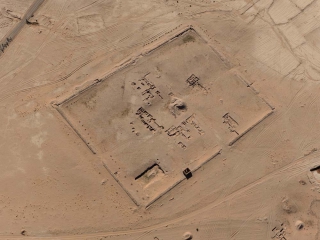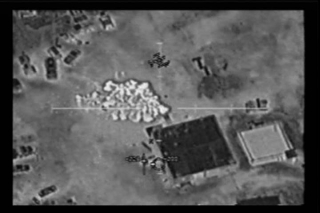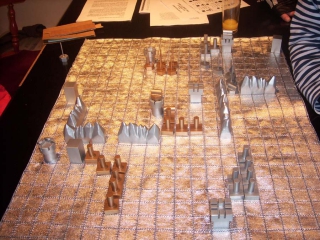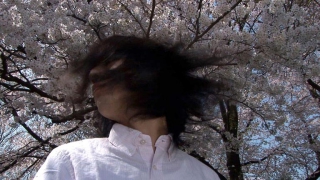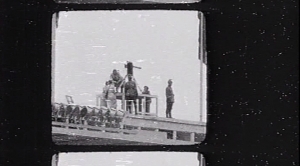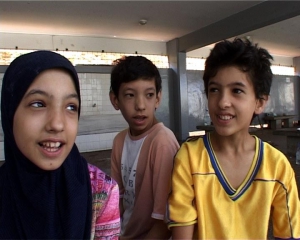In 1988, the media art festival transmediale was founded under its name “VideoFilmFest” in the periphery of the film festival Berlinale; in 1998, it recieved its current name. There is not only a conference, but also an open competition, an exhibition and various side events. This year’s subject is called “RESPONSE:ABILITY”. In 2011, too, several works address war.
Aesthetics of Disappearance by Jananne Al-Anis (2010)
In 2010, Jananne Al-Anis made her 15-minute video “Aesthetics of Disappearance” in the South of Jordan, exploring the disappearance of the body in real and imagined landscapes of the region. The film documents both ancient remains and cattle farms, abandoned locations and military installations, all of which shaping today’s Jordan. Jananne Al-Ani (* 1966) studied fine arts at Byam Shaw School of Art and received an MA in Photography from the Royal College of Art in 1997. Besides several others, she already had an exhibition at the Imperial War Museum. Being part of the programme segment Arab Shorts, it will be shown on3 February at 1830h.
The US experimental film maker Dominic Angerame (* 1949) shows his video work “Anaconda Targets” (2004). The video of 11 minutes consists of cut scenes made by an attack helicopter that in March 2002 took part in Operation Anaconda of the Afghanistan War. One can hear the pilots’ voices; targets are being designated and attacked. On the transmediale’s website, it is being said that: “with this he creates an ambivalent perception: Is this actual military surveillance imaging or a videogame? This ineluctable appositeness of clichés leads to shocking irritations.” Well, or rather not, keeping in mind that in 2011, YouTube and many other websites host countless videos by such target systems. “Anaconda Targets” is being shown as part of the Man & Machine short film segment on 6 February at 1830h.
Anaconda Targets by Dominic Angerame (2004)
ClassWargames presents the board game The Game of War by French artist Guy Debord (1931-1994). Richard Barbrook, Stefan Lutschinger and Ilze Black will be introducing the ClassWargames film on Debord’s ludic experiment and then hosting a collective playing of The Game of War while discussing its importance to our understanding of Situationist theory and practice. According to Debord, the players (aka “revolutionary activists”) should learn from the military model to become good class warriors.
Having said that, this militarist approach is – of course – non such, according to the protagonists: “In their situationist war game, competitive play stimulated psychological intimacy between the sexes. Winning or losing were equally pleasurable experiences. By rewarding solidarity in its play, the Game of War acts as a tool of anti-militarisation of our revolutionary struggles.”
In a similar abstrusely, the military background and heritage is being addressed. In the film, it is being seid that: “Not surprisingly, the lessons of the Game of War have already been adopted by the class enemy, whether in the board rooms of big business or in the operations rooms of this or that military organisations. But we know it is the essence of capitalism to take our greatest contributions to human progress and turn them into weapons against us.”
Carl von Clausewitz, a class warrior? Antoine-Henri Jomini, a Communist, beg your pardon, situationalist? Both are being extensively quoted, among other military theorists, and thus provide for the witty moments of this film. The game by itself reminds of a rather clumsy copy of early military strategy games, e.g. the “Taktische Kriegsspiel” (tactical war game) by the Prussian war councillor Georg Leopold von Reiswitz from 1812. In both these games, there are artillery, cavalry, and infantry units – all that you need for a revolutionary struggle against the class enemy in cyberspace. Horrido!
On 7 February 2011 at 1900h, the aforementioned film will be screened, follewed by a match of The Game of War with the remaining participants.
The Game of War von ClassWarGames
On 3 February 2011 at 1830h, the short film segment “Inner Wars” presents a couple of interesting works: The German-Norwegian video artist Bjørn Melhus (* 1966) shows his work “Murphy” (4 mins). In this synchronised sound and light installation, the artist combines coloured light with soundtrack elements of the movie “Blue Thunder” in which the cop and Vietnam war veteran Frank Murphy (Roy Scheider) struggles against a conspiracy: in the showdown, the sky of Los Angeles becomes a war zone. On Melhus’s website, one can watch a short sequence from this fascinating work.
Also in the “Inner Wars” segment, a work by the Japanese artist Tomoko Inagaki (*1975) from 2009 can be seen. She addresses an important Japanese symbol in her film “Sakura (Cherry Blossom)” (3 mins), the annual cherry blossom that stands for beauty and and the celebration of spring. In the era of the Second World War another aspect of the flower, that it disintegrates upon blossoming, was used to illustrate the spirit of brave soldiers. It was seen as a virtue amongst Japanese soldiers that they must not fear death and die gracefully for their nation. This association with the cherry blossoms is hardly remembered today but elders remain to whom the flower stands for unpleasant memories. In the video we see a person shaking his head below the cherry blossoms. The movement grows harder until someone slaps his face and the sound turns into shooting.
Sakura (Cherry Blossom) by Tomoku Inagaki (2009)
In the historical segment “The First TV” (5 February at 1430h) several film documents can be found that are hardly shown: The station idents of the “Deutscher Fernseh-Rundfunk” (DFR) from 1935 (3 mins) are being shown, followed by a 9-minutes montage on the preparations for the Reichsparteitag in 1936 (Nuremberg Nazi party rally) and a 7-minutes montage on the Olympic Games of 1936 for which new media were exentsively used by the Nazis for propaganda purposes. The DFR was the programme of the world’s first TV station “Paul Nipkow” (named after an inventor of an early TV system); it broadcasted from 1935 until winter 1944.
Berlin 1936
Equally interesting are the films “Berlin nach einem Bombenangriff” (Berlin after a bombing raid; 1940, 7 mins), “Bauernarmut in Sowjetparadies” (Peasants’ poverty in the Soviet paradise; 1941, 5 mins, a propaganda film showing the inhabitants of a Soviet village after the Wehrmacht occupied it), “Wie baue ich meinen Ofen selbst?” (How do I build my own oven?; 1943, 8 min; this movie, too, refers to the consequences of war) and not the least a 14-minutes montage of “Kalenderblätter – August 1943” (calendar sheets). This TV magazine was primarily developed for soldiers in military hospitals to present them complacent information from home; here, it is an idyllic day in summer in Berlin, contrasting the real situation of the war and the increasingly bombed-out Berlin.
The segment “Agit-Prop, Punks and Poets: Digital Media in the Arab World” (4 February, 1430h) may also be of topical interest: Lebanese artist Mahmoud Hojeij (* 1975) portrays with “We will win” (2007, 8 mins) the try to solve the Arab-Israeli conflict through the means of a talk between three men. The Lebanese film maker Rania Stephan presents four of her eight short films “Lebanon / War” (together 30 mins), showing how the average Lebanese is organising daily life during and directly after the Lebanon War of 2006.
LEBANON / WAR by Rania Stephan (2006)
The complete transmediale programme can be found here; the main venue (amongst others) is the Haus der Kulturen der Welt.
transmediale.11 – RESPONSE:ABILITY
Festival pass 80 € (concessions 45 €)
Day pass 25 € (concessions18 €)
Tickets for single events vary (please see here)
Haus der Kulturen der Welt
John-Foster-Dulles-Allee 10
10557 Berlin
Germany
